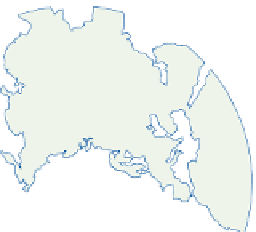Geoscience Reference
In-Depth Information
(A)
(B)
90°E
COLD
LOW
COLD LOW
H
L
WARM
HIGH
WARM
HIGH
180°
L
0°
Surface isobars
500mb contours
Figure 7.2
The characteristic slope of the axes of
low and high pressure cells with height in the
Northern Hemisphere.
H
latitude southward at 3km, and towards the west.
Even so, this slope of the high pressure axes is not
constant through time.
90°W
90°E
2 Mean upper-air patterns
The patterns of pressure and wind in the middle
troposphere are less complicated in appearance
than at the surface as a result of the diminished
effects of the land masses. Rather than using
pressure maps at a particular height, it is more
convenient to depict the height of a selected
pressure surface; this is termed a
contour chart
by
analogy with a topographic relief map (see Note
1).
Figures 7.3
and
7.4
show that in the middle
troposphere of the Southern Hemisphere there is
a vast circumpolar cyclonic vortex poleward of
latitude 30°S in summer and winter. The vortex
is more or less symmetrical around the pole,
although the low center is towards the Ross Sea
sector. Corresponding charts for the Northern
Hemisphere also show an extensive cyclonic
vortex, but one that is markedly more asymmetric,
especially in winter, when centers are found over
eastern Canada and eastern Siberia. The summer
pattern shows a much weaker vortex, centered
over the pole. The major troughs and ridges,
especially well illustrated for the Northern
Hemisphere winter, form what are referred to as
longwaves
(or
Rossby waves
) in the upper flow.
It is worth considering why the hemispheric
westerlies show such large-scale waves. The key to
180°
0°
L
90°W
Figure 7.3
The mean contours (gpm) of the
500mb pressure surface in January and July for
the Southern Hemisphere, 1970-1999. Gpm =
geopotential metres.
Source: NCEP/NCAR Reanalysis Data from the NOAA-CIRES
Climate Diagnostics Center.
this problem lies in the rotation of the earth and
the latitudinal variation of the Coriolis parameter
(Chapter 6A.2). It may be shown that for large-
scale motion the absolute vorticity around a
vertical axis (the sum of relative and planetary
vorticity, or
f
+
ζ
}) tends to be approximately
conserved, i.e.,
d (
f
+
ζ
)/d
t
= 0













































































































